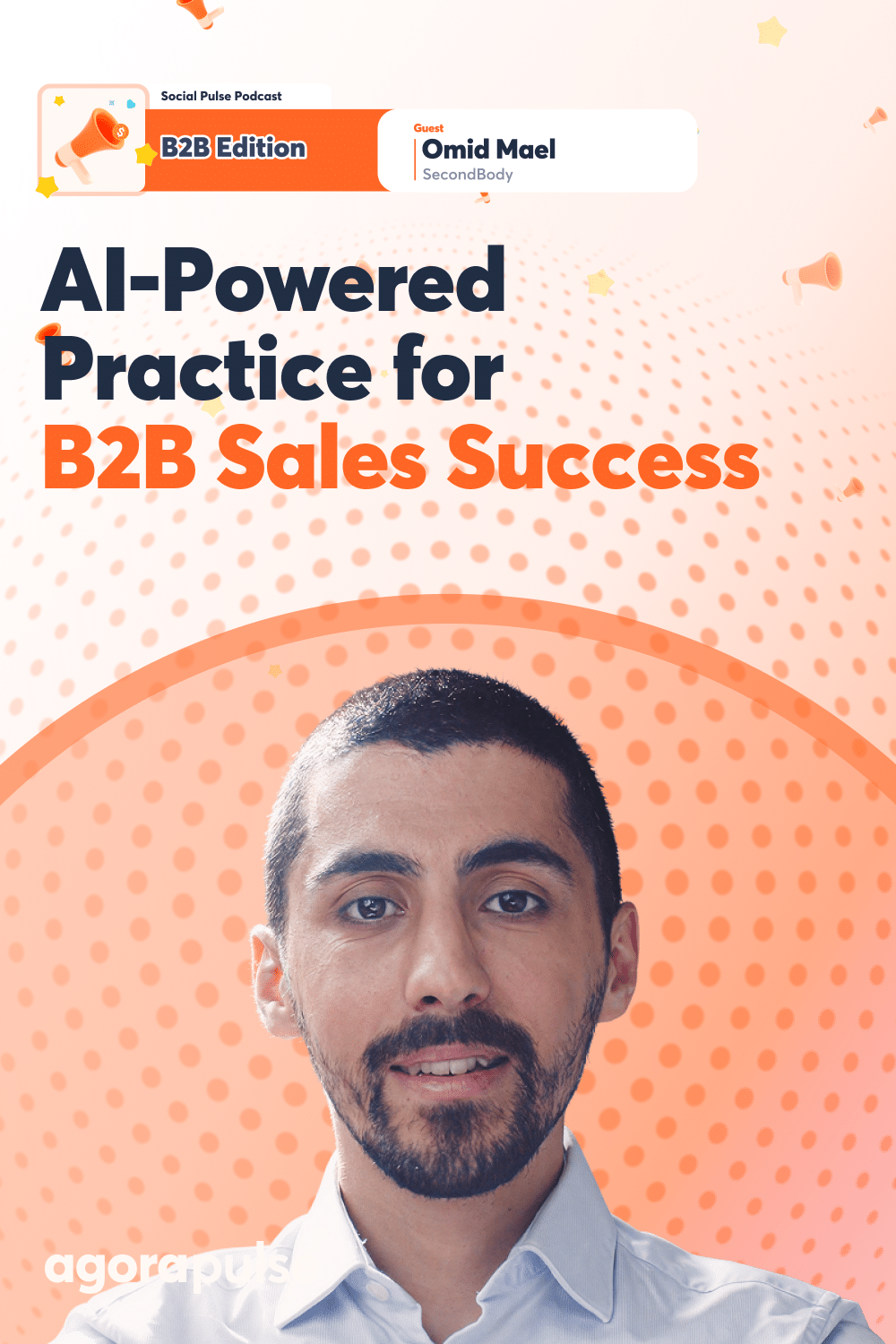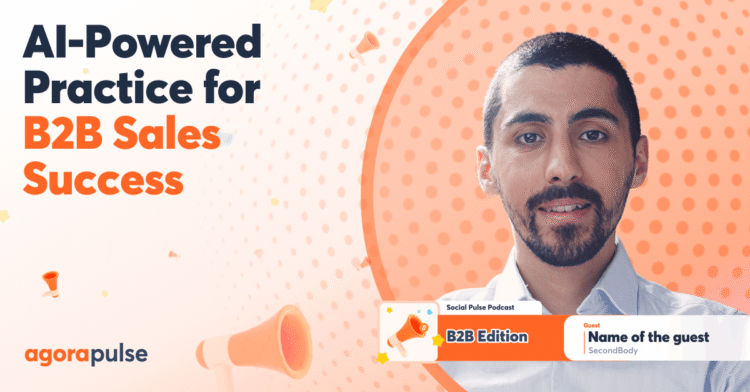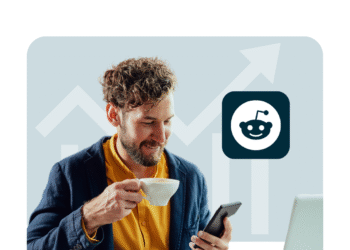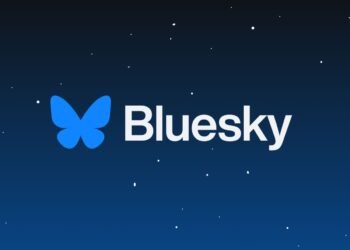Have you ever hung up from a sales call and immediately thought of all the better responses you could have given? Or maybe you’ve sent your sales team into important conversations, only to discover they weren’t fully prepared for the tough questions that came their way. In today’s high-stakes B2B environment, a single conversation can make or break a major opportunity.
Sales leaders are caught in a difficult position. How do you scale personalized coaching across your entire team? How do you ensure consistent messaging while allowing for authentic conversations? And most critically, how do you know your team is ready before they engage with those valuable prospects?
That’s exactly what our guest today has been working to solve. Omid Mael, CEO and co-founder of Secondbody.ai, is pioneering the use of predictive conversational AI to transform how sales teams practice critical conversations with his extensive background, scaling sales organizations, and building enablement programs that delivered measurable results.
Share a little bit more about that journey from sales leadership at Livestorm to founding Secondbody and the problem that you identified that needs solving
Omid Mael: Yeah, the story it is still something super interesting to me. I think Secondbody found me and not the other way around.
I was obviously super busy building and scaling a SaaS business back in 2022, and something weird happened. There was this smart, broadway actor who reached out to me on LinkedIn and I remember his cold outreach on LinkedIn was “Hey, I’ve built a software for Broadway actors for them to be able to practice their lines before they go on stage, and I wanna see whether or not this could be also solving the same issues for sellers. Would you be open to giving me a few minutes of your time?”
I was intrigued, I said yes to a demo. I remember we sat down, and during the demo, I had some goosebumps. I was like, “I’ve never seen this before,” and it was the exact same thing that me and my twin brother used to use as a framework in order to learn English as a second language.
So you might hear an accent because English is not my first language. I was born in Iran and then moved to France, so I’m an immigrant, and then I’ve been learning different languages on my own. Back when we were 12 with my twin brother, we used to play BBC cassette, the audio cassette, if you remember. And we used to actually rewind them over and over just to pick up the accent, the pronunciation, and that’s how we became bilingual back then and Arlo, the original founder of Secondbody had built a software around the same mechanism, which is repetition based practice for actors to practice their lines before they go on stage.
Long story short, I said yes to a demo. Then, to pilot a couple of weeks in, I saw two things improve drastically. One was our conversion rates. And the other one was the sales cycle, which was short. Arlo and I, we came to the conclusion that this is something that we are breathing every day. I resigned from my previous role, and I joined Arlo full-time with zero salary.
And obviously things happen, Arlo had to move on for different reasons, and I took over the whole adventure, and we’ve actually been building Secondbody around the exact same problem: How do we bring people to their better versions when it comes to the conversations that they’re having on a daily basis with their prospects, with their clients, with any other stakeholders that they’re dealing with?
Mike Allton: I love that. I am not in sales. I’ve done sales in the past, but I’ve helped our sales team. I was just remarking earlier today in a meeting in fact, that it was at one of our in-person retreats just north of Paris a few years ago, where I got tapped to play the role of a sales or marketing agency owner for some sales role play exercises that we were doing. So I’ve been on that side of it.
What do you see as some of the gaps in traditional sales training, like what I just talked about, or enablement approaches that you think AI is just so well positioned to address those gaps?
Omid Mael: I’ve been having more than probably 700 different sales conversations with so many different CROs, sales directors. VPs of sales across different B2B companies for the last couple of months, and the commonality across all of these people is one thing. They have the honesty to admit that there is an explosion of insight on what their top performers are doing differently.
They’ve got Gong, they’ve got AI on top of that. They’ve got a very sophisticated CRM, and then the same folks, they bluntly admit that despite this explosion of insights, the gap between their top sellers and the rest of the pack hasn’t been shrinking. It’s been the other way around. So for them, traditional sales training is like planning for an exam where the questions are all written in disappearing ink.
They want the reps to memorize the frameworks, the scripts, even the objection-handling cheat sheet that they have put together. But the second, the real conversation gets messy. Blank slate. You said it beautifully, Mike, right? There are fewer and fewer conversations out there, and the actual enablement space as we have it today, we think it’s broken because it has never been able to address the issue.
Top performers are nailing it. Average performers, there are still the same folks who are putting down the performance of the team, because of the two of us. You work with them, you coach them, they get better for a while, but back to their old habits. And then you realize that conversations start going south, and even Gong is capturing that at scale, but you don’t know what to do with that.
Mike Allton: Got it, so we have these kinds of assistance technology solutions, that sales enablement and sales coaches, and sales managers have been trying to implement. To your point, they’ve struggled to really identify why the top performers are performing the way they are, and they’re struggling to help the entire team.
Can you walk us through what generative AI or predictive conversational AI means in like practical terms, and how that differs from some of these other sales technology solutions that people have been turning to in previous years?
Omid Mael: Yeah. I think in order to paint a better picture when it comes to understanding what predictive conversational AI is, you probably need to understand what it is that we are seeing when it comes to the most sales tech across different B2B companies? The way I’ve been describing it when talking to other leaders is very simple. Most sales tech is like a Monday morning quarterback. You get a highlight reel of where you fumbled, where your team is dropping the ball, but it’s probably too late to change the playbook.
And when it comes to conversational AI and the beauty that it has, it’s more like a sparring coach in your ear during that fight, right? Calling out the next punch before it lands. It doesn’t just report mistakes, it creates them at scale. So think about something which is live. Things predicts the real-life objections that your reps are very likely to face and throws them in during the training in a safe environment, judgment-free.
That way, by the time they hit the real call, they’ve already been able to see that, and to get punched in the face. But again, this is only and only available and possible with predictive conversational AI because. In our space, what we’ve seen so far is that AI is probably one or two steps ahead of the game whenever you’re talking about a topic, and having that is exactly what has been able to flip the script, not only for the sellers but also for the managers.
Mike Allton: I love that sports analogy. I’m gonna double down on that for a moment, ’cause you’re right. Traditional sales technologies today are more like the video that you get to watch in the locker room after the game, where you can’t impact the outcome of the game any longer. It’s done, but you can potentially learn from mistakes and maybe try to improve on that in the next game.
But with AI, you’ve got a coach that’s in your ear, while the play’s running, who’s telling you, “Hey, look to your right, that receiver’s about to be open.” And more importantly, because it’s artificial intelligence or predictive, it’s saying, “Hey, what on this next play, call this route because this offensive lineman is slowing down and he’s not gonna get to you.”
It’s able to give you those kinds of insights from obviously a B2B sales perspective. So let’s talk about B2B sales. I know a lot of the folks listening, they’ve got BDR teams, they’ve got AE teams. They’re dealing with long sales cycles. We’re not talking about selling retail widgets on this show.
Are there specific types of sales conversations that tend to benefit more or the most from this kind of AI-powered practice? Are there particular moments, like the really high-stakes moments, where you’ve seen a really great impact?
Omid Mael: In my experience working with so many different B2B companies, anywhere a rep might freeze, fumble, or probably default to rambling, that’s where AI practice does a very beautiful job. Think cold calls, pricing combos, those trends, why should we actually switch? That’s like simulating turbulence in a flight simulator, right? If you’re a flight and then, or even a pilot, you know exactly what it means. You don’t train for perfect weather.
So the question that we’re asking ourselves is, why do you train your reps in a very perfect environment where they know exactly what the manager’s gonna be throwing at them, because, say, training has become this repetitive, predictable kind of exercise. We think whenever you can actually train for chaos, that’s where AI practice pays off.
So when the pressure’s on and the reps need to stay calm, confident, and in control, it doesn’t matter what kind of conversation we’re talking about.
Mike Allton: I’m reminded of the late great Gene Hackman, who recently passed away, and I was rewatching Crimson Tide in a kind of tribute to him. It’s one of his greatest movies, and there’s this fantastic scene … He’s a submarine boat captain, and they’re in maneuvers, and Denzel Washington is his executive officer, and there’s a fire in the galley, and Denzel happened to be close by. He runs down there, he is helping to put out the fire. There’s a man who’s injured and getting medical care, and at that particular moment, Gene Hackman calls for a missile drill.
The entire boat’s gotta scramble and go through an exercise, and Denzel’s like “What are you doing? We’re trying to put out a fire. This could flare up at any moment.” And the captain says, “What do you think? We’re only gonna practice when everything’s hunky dory, cause that’s what life is like? No. You gotta practice when things are chaotic. That’s the best time to run a drill. ‘
So I love that point that you just made.
Walk us through what this AI-based practice actually looks like or works like in your experience.
What’s the process for a sales rep to use this technology to prepare for their conversations?
Omid Mael: Yeah. I think by the way, that’s a very good transition because what we are hearing at large is, hey, is this like a ChatGPT wrapper? Because we can probably do that with ChatGPT. I think as of today, what would make this stand out, and that’s where we are focused on, is distribution. By distribution, we mean how is it that the rep is gonna be experiencing this at scale?
Imagine a flight simulator, but for sales, right? The rep logs in, picks up a scenario that has been assigned to him by the manager or by the enablement folks. Let’s say, handling the classic. We’re happy with the vendor that we have, or it’s gonna be a waste of my time to have this conversation with you.
And then the rep gets dropped into a three-minute, four-minute, seven-minute role play with AI. That has been used to build that persona, which mimics the RCP that the company is selling to. And by the way, that persona doesn’t pull punches. It does interrupt, it hesitates, even throws shade. And what’s so interesting about this is that after the round, the rep can instantly get the performance feedback. Your talk-to-listener ratio, the filler words. The sales methodology that you’re using, whether it’s vice, sad, or whatsoever, and the exact same flow that I’m sharing with you, would’ve probably taken a manager 35 to 15 minutes to prep, to do, and to deliver when doing a one-on-one coaching. So if your manager is having probably 10 reps, that’s easily 10 hours a week.
And also your manager is probably doing a poor job because he’s having his head into the dashboards, the numbers, saving some of the opportunities that are going south. So often times reps, they have the honesty to admit that they’re not getting any value when it comes to spending time with their managers, getting some coaching, or whatsoever.
Mike Allton: Love that point, cause I had the same thought, I could do this with ChatGPT, could have a conversation with ChatGPT, but to do it well, to do it at the level that Secondbody is doing it, I would have to train ChatGPT through the prompt or through a custom instruction, like a custom GPT.
What I’m looking for, I would have to make sure ChatGPT understands the specific type of sales framework that I’m supposed to be following, so that it knows who we’re talking to in terms of our target audience. Sure, you can give them the name and position, and the company. They could probably role-play as that individual, but they’re not gonna be able to give you that feedback like a coach would if they don’t understand what they’re looking for.
Mike Allton: I think some of the folks listening might be a little worried about how AI can sometimes sound very robotic, and particularly if we’re using AI to train our sales staff. Won’t it sound scripted, won’t they as well sound robotic? How does this help maintain balance, consistency, and authenticity in sales conversations?
Omid Mael: I would’ve said the same thing if I were sitting on the other side of the equation as a sales leader, right? I think at the end of the day, one thing that has been so eye-opening for the different stakeholders that we’re talking to is that they know great sales isn’t just about reciting scripts.
It’s like jazz. It’s not opera. You need rhythm. You don’t need rigidity. And to your question, oftentimes people tell us, is it like a dating app where as soon as the match is made, people are not gonna come back? Is it like, if I’ve done one role play, I’m not gonna come back to this at all. And one thing that I’ve learned as a seller is that if your product is solid enough, it should be doing the selling itself.
So you actually throw people into a role play. We ask them to do that for a second time, so two times, three-minute conversations, and they realize that these two conversations are so dynamic, so different, and that the flow is built for the seller to feel as if there’s a second shot, a third shot to have.
Within that scenario, the managers are like, okay, not only can we scale, but we can also go beyond the scenarios that we have today. When it comes back to the reps, one thing that I’ve been learning so far is that reps appreciate having a safe environment to F up. They tell us, is there a way for me to be able to screw up my own calls without my managers to see that?
Because I don’t wanna feel intimidated. So at the end of the day, you realize that you are giving people a container of what good looks like, what bad looks like, judgment-free, and we’ve seen actually the adoption go all the way up to 65, 70%. Whereas if you compare that with the legacy vendors like an LMS, we’re talking about three to 5%.
So I think that’s another beauty of using AI, I’d say.
Mike Allton: So a great sales rep is gonna understand the importance of overcoming objectives. Let me flip it around to you for a second and give you that opportunity.
What are some of the resistance points that you’ve encountered when it comes to just integrating AI and systems like yours, and how do you help organizations overcome those objections?
Omid Mael: I think the classic one is: Are you going to be replacing me? Are you going to be listening to me to learn how to speak to the prospects? And I think in an era where every company out there is getting funded to replace human beings, I have one mission only, which is to enable people to become a better version of themselves.
And that’s by enhancing their superpower, which is conversations. You and I, we can do so many things through automation, and I think we’re gonna be grateful to that. But the last thing that we wanna automate is actually this conversation that we are having right now. So reps, by the time they realize that we are here to make them better and reinforce their skills.
They actually make peace with that, and obviously, if the rep is happy with that, the manager is seeing the adoption go up and the performance getting better.
Mike Allton: As I gotta say, as the chief storyteller, the guy who’s doing this kind of conversation, obviously all day, every day, that message resonates with me.
Hopefully, this is not something that AI can replace. I know there are amazing podcast tools coming out from Notebook LLM and those kinds of places, but it’s still not one-to-one human conversation or one-to-many human conversation, and it’s not relationship building, which is what, hopefully, you’re accomplishing through sales.
Omid Mael: I think in full transparency, I myself am so grateful to Gong out there. So anything that is capturing what’s being said on the front line.
So, any call recorder out there? I think there was an after and a before when Gong came in, it was like, and this is the analogy that I was given by a manager, Gong is like the light that you have when you walk into a very dark room. In the past, we didn’t know what was going on actually within that room, whether or not that was chaotic, or if it was probably clean.
And then you turn it on and you realize, oh boy, I had no idea that my reps, they were actually saying these kinds of stuff to land the customers. Now you have Gon,g but it is not solving your problem, which is the performance gap. You’re using Secondbody. So I think the perfect marriage is whenever there is a call recorder, and then we come in to shrink the gap.
And obviously when it comes to the CRM, it’s the perfect combination because that way you can easily cross-map the performance through practice and through real metrics that is being captured, because people who are either booking more meetings or dropping the ball.
Mike Allton: Love it. So, using a tool like Gong helps you illuminate the problems that you have.
And we all have problems of some kind. We all have gaps, but it’s a tool like Secondbody that’s gonna help you actually address those problems and solve them.
Is there anything that we didn’t touch on when it comes to Secondbody or sales enablement in general that you wanna make sure you impart on our listeners?
Omid Mael: Yeah, I think that’s a good question, by the way. One thing that I’ve been learning, and it’s been so humbling to me, is the fact that having more tools doesn’t mean that you’re getting that problem solved. I’ve been talking to tons of different sales reps who have the honesty to admit that they feel like they’re going from one platform to another platform, and they’re not getting any job done.
They’re being asked to do this here and then go and do this there. The only thing that they care about is whether or not the platform that they’re using is adding value to them. And again, it’s been so humbling to me because I realized that a company having Gong, a very solid LMS, that I cannot name, a very solid CRM, like Salesforce, they have had roughly 35 reps coming back to SecondBody because they hadn’t been able to get the value that they were trying to get from either of those platforms. So I think we are gonna be seeing something very unique in the next couple of months, Mike, where less is gonna be doing more. And I’m rooting for that space because reps, they don’t really need that many tools to be living with.
Mike Allton: I couldn’t agree more. I see the same thing on the marketing side and even in other departments. As a company, we add, and I’m speaking, we generally, not just Agorapulse, we add tools, we add processes, because taken individually, that sounds like a great idea. Yes, we should add that tool that automates this, that, or the next thing, or that helps us do one thing or another.
Or yes, we should add a new communication platform or yet another Slack Channel. But then, no, when you add it all up, it ends up being overwhelming and too much. Our sales enablement leader, Jenny Brennan, and I were having a conversation with her recently about something that I wanted to do, which would have sent a notification to all of our AEs on a weekly basis, and she had the wherewithal to say, “You know what? They’re probably already getting too many opinions on a weekly basis. Maybe we could think of another method that isn’t quite so intrusive to all of them, and that makes sense to me.” I was thinking about my individual goal. Yeah. And not seeing the bigger picture. So you’re right. Fewer tools.
What resources, whether it’s podcasts, blogs, influencers, are you following to just stay current on everything that’s going on with AI and sales enablement?
Omid Mael: Sure. I think I’m big on LinkedIn. If you’re following the right people, including you, Mike, I think you get enough in terms of the updates and what’s trending, what’s good, what’s bad.
I’ve tried to eliminate so many other social networks that I’m using, so I’m only, and only having LinkedIn and TikTok. I’m big on newsletters. There’s one that I appreciate receiving probably every two days, which is called That Startup Guy, keeping me updated with the new things that are coming out.
And apart from that, talking with folks, honestly, talking with reps, I think we take conversations for granted. We think watching, reading more is gonna be doing a lot of good things, but I’ve learned way more through conversations, and I always appreciate talking to a stranger, so that has been one of the mediums of my music.
Don’t forget to find the Socialpulse Podcast B2B Edition on Apple, and drop me a review. Let me know what you think. Let me know what you’d like to see us cover in future episodes.















